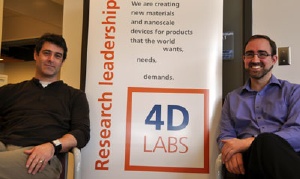Jul 9 2009
SFU's 4D LABS materials science research centre is getting about $884,000 from Western Economic Diversification Canada to add new scientific equipment for faster prototyping.

The Burnaby campus facility houses materials fabrication and design operations that help scientists research and create new technologies. The equipment will help accelerate product commercialization and spin-off companies in key sectors such as nanotechnology, energy and life sciences.
4D LABS executive director Neil Branda and nanofabrication director Byron Gates—both Canada Research Chairs and renowned material scientists—will use the funds to build a Canadian state-of-the-art mask-writing facility in the centre’s already impressive nanofabrication laboratory.
Masks are the stencils used in nanolithography to determine which areas are exposed for etching during the fabrication of devices such as semiconductor integrated circuits and nanoelectromechanical systems.
"This new facility will transform academic and private industry researchers’ ability to quickly and cost-effectively develop and design new micro- and nanofabricated materials and devices," says Branda, a 4D LABS cofounder.
Using lithographic and mask-making processes, scientists can pattern materials with nano features to create foundations for new technology platforms. For example, nanofeatures could form the critical components in electronic and biomedical diagnostic devices.
Currently, the closest source of masks with micron-scale features (500 nanometres to 100-plus micrometres—about the diameter of a human hair) is Alberta. The SFU mask-writing facility will be able to produce nano- and micron-scale features and structures less than 20 nanometres (about 10,000 times smaller than a human hair).
Researchers will also be able to rapidly write features directly onto materials and structures, eliminating the need for extensive lithographic patterning and allowing for the creation of 3D nanoscale features.
"This capability will eventually be as key to nanoscale materials fabrication as the photocopier is to information dissemination," explains Gates. "We’ll be able to fabricate the next generation of technologies, particularly in the fields of alternative energy and biomedical engineering."